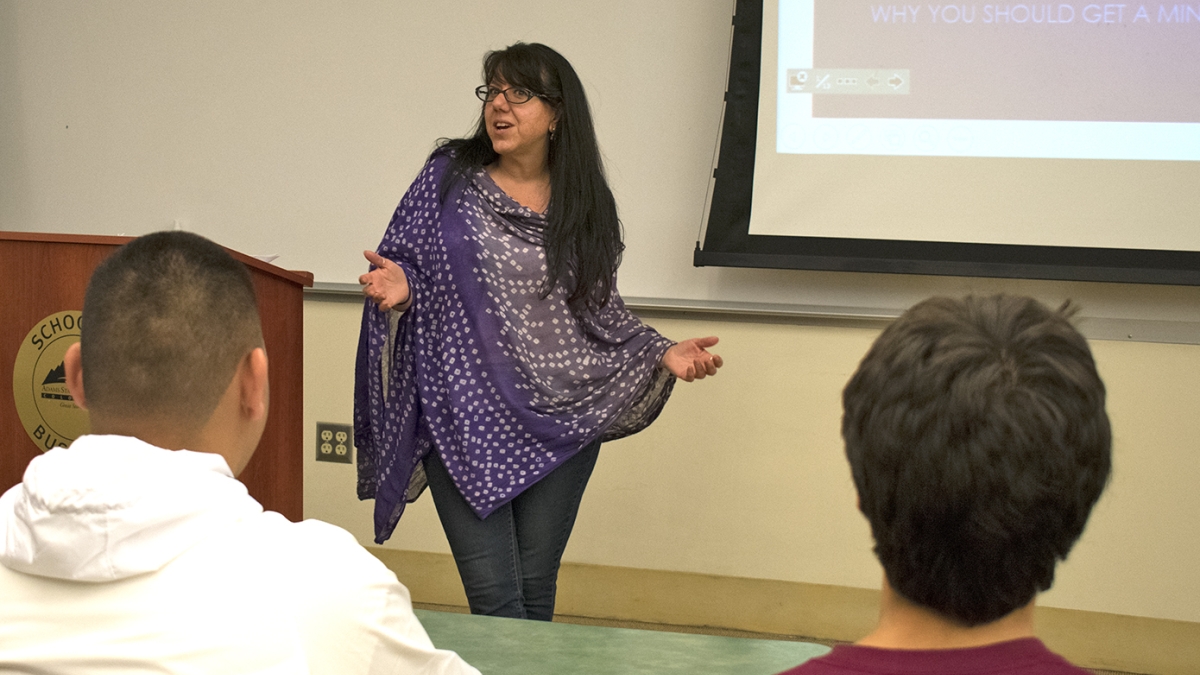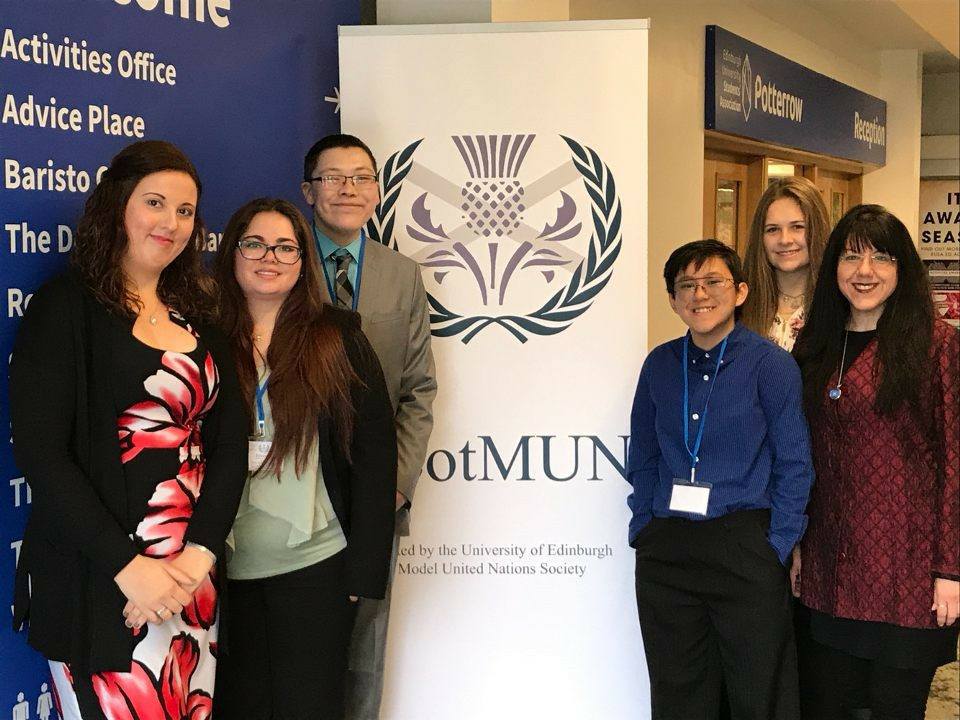ASU alumna shares career insights

Lisa-Mari Centeno, ASU PhD alumna, teaches political science at Adams State University in Colorado.
Arizona State University political science PhD graduates are employed both in a range of professions and more traditionally as professors at universities all over the globe.
Lisa-Mari Centeno, who graduated with her PhD from the School of Politics and Global Studies in 2003, has made her impact at Adams State University in Colorado. She is currently the only Latina full professor for her university, which is designated as a Hispanic Serving Institution. Centeno also advises an internationally award winning model U.N. team and is the university's women’s and gender studies director.
Here, Centeno shares some takeaways from her career in academia thus far.
Question: Adams State University was Colorado’s first higher education institution to be designated as a Hispanic Serving Institution. What has your experience as a professor of political science there been like?
Answer: It was very important for me to serve at a Hispanic Serving Institution (HSI) because I was the only Latina in both my undergraduate and graduate poli-sci courses; so I consider myself very fortunate to have been granted a position at Adams State University, the other ASU.
There is, of course, no single Latino culture, but many that overlap one another. The Latino culture of the San Luis Valley is a new layer that I, as a Venezuelan-American, find familiar, but with its own nuances. This is to say that just being categorized as “Hispanic” does not mean one will automatically understand what it means to be at an HSI. At least for me, there was a learning curve.
Although Adams State is an HSI, in a larger sense, I would say that we are a USI: Underserved/Underrepresented Serving Institution. Many of our students, of whatever ethnicity, are first-generation, from low-income backgrounds. Adams State provides an opportunity for those who might not otherwise be able to obtain a college education. This is a source of pride for us.
I chair the LatinX Faculty and Staff Caucus, and one of our ongoing campaigns is greater recruitment of talented Latino/a faculty and administrative staff. It is important for our Latina/o students — but really for all students — to see examples of Latina/o success. On the first day of each semester, I always share with my students that I was a first-generation student from a poor, immigrant family. My hope is that they will think, “Well if she can do it, I certainly can.”
Q: What does being an advisor for the university’s model U.N. team entail? How have you noticed an impact to students who have participated?
A: Model United Nations is the very best part of my job. With the support of the university and the enthusiasm of many hard-working students, MUN has developed from a casual club to an upper division course to an award-winning team. I am very demanding and have extremely high expectations of my team members, who spend many hours every week in order to prepare for international conferences and, of course, to fundraise. Many of our students had never been on an airplane, or traveled outside of Colorado before their first model U.N. conference, yet they have competed and won against teams from elite universities from all over the world. I think it is a testament to Adams State that our students have the same opportunities afforded to students elsewhere.
Centeno's model U.N. team in Scotland.
Q: How do you think your time at Arizona State University helped you prepare for your current position?
A: Arizona State gave me the opportunity to teach, so it is where I recognized that I wanted to be a teaching professor first and foremost. If my students are confident in their preparation when they graduate from Adams State, it is in large part because of the preparation I received at ASU. Maybe I should not admit this, but I did not fully realize how much I had learned until I started teaching, especially classes outside of my direct area of specialization. The feminist nature of my dissertation research meant that I was able to work with women’s studies faculty, which helped prepare me to take on the role of women’s and gender studies director at Adams State. As I’m sure is true of all faculty, I try to emulate my own professors. I owe Drs. Roxanne Doty, Michael Mitchell, Amy Lind and Richard Olson a great debt of gratitude. I try to pay it forward to my own students.
Q: What advice would you give to Latina students who wish to pursue a career in academia?
A: I am frequently asked this question, and I wish I had the magic words. Though the landscape is changing in academia, as Latinas, you are likely to be members of the “only” club: the only Latina, and perhaps even the only woman. Learn from my mistakes. I rarely spoke in graduate courses and felt intimidated when I began my career as the only woman in my department at Adams State.
Don’t take as long as I did to realize that it’s “OK to be a chingonaSpanish slang term for a strong woman; it has generally had negative connotations, but many in the Latinx community aim to "take back" the term..” This is my email signature quote, by Sandra Cisneros. It may not be the most professional language, but I hope it sends a message about challenging societal expectations. I think all marginalized groups have some familiarity with cultural code-switching, and in academia it’s no different.
Think about how you want to handle this. If you assimilate to advance your career, you might be accused of “selling out.” If you are vocal, you might think you are fulfilling the stereotype of “sassy” Latina. Don’t worry about that; you may well have to advocate for yourself, so speak up! Ironically (or maybe not), underrepresented groups in academia are often burdened with additional service to the university, such as extra committees, all in the name of greater representation. The trick is learning to say no to inordinate service demands without jeopardizing your career, especially if you are not tenured yet. I won’t pretend to have mastered this trick, but again, I encourage you to advocate for yourself and recognize the value of your time.
I also suggest finding a Latina ally and/or mentor. I did not do this, but wish I had, especially earlier in my career. If there is no LatinX faculty organization where you are, do you have enough colleagues to create one? If not, contact those at other schools. Feel free to reach out to me! HACU (Hispanic Association of Colleges and Universities) conferences are also really great places to find support. I encourage you to also mentor students, not just Latino/a students. Doing so has helped ground me in my role as faculty. Working with students can also counter some of the prevailing negative images of Latina/os. Perhaps it should not be our responsibility to dispel myths, but for the time being it is our obligation so that future Latinas will not have to repeat history.
Answers have been edited for length.
More Law, journalism and politics
Can elections results be counted quickly yet reliably?
Election results that are released as quickly as the public demands but are reliable enough to earn wide acceptance may not…
Spring break trip to Hawaiʻi provides insight into Indigenous law
A group of Arizona State University law students spent a week in Hawaiʻi for spring break. And while they did take in some of the…

LA journalists and officials gather to connect and salute fire coverage
Recognition of Los Angeles-area media coverage of the region’s January wildfires was the primary message as hundreds gathered at…


